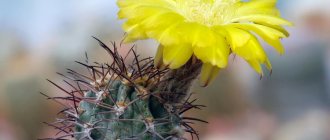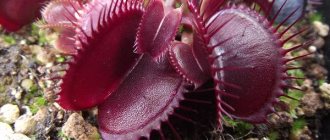Cyclamen is a small plant that gardeners successfully grow from seeds at home. Of course, it’s easier to buy it in a store or ask friends. But such an opportunity is not always available. Then those who want to keep this flower at home can only sow and grow it with their own hands. And we will help you by telling you how to do it correctly.
Description, types and varieties
Cyclamen is a perennial herbaceous plant from the Myrsinaceae family. It is also called alpine violet or woody violet. In the wild, it grows in northeast Africa and East Asian countries, as well as in the Mediterranean.
Cyclamen has a hidden tuber underground, from which new rounded leaves on long petioles grow from year to year. They are dark green in color and often have a striped pattern of light silver lines. During the flowering period, cyclamen forms many long peduncles rising above the rosette of leaves. And bright flowers with an unusual shape bloom on them. Their color depends on the type and variety of the plant. After flowering ends, the leaves fade and a dormant period begins, which lasts up to 5-6 months.
There are about two dozen species of cyclamen, but only two of them are grown at home:
- European;
- Persian.
These two flowers are very similar in appearance, but still have the following differences:
- Tuber . In the Persian, it looks out of the ground by about 1/3. But for a European it is hidden by the ground.
- Leaves . In the Persian the back of the leaves is green, while in the European it is blue-green or green with a purple tint.
- Bloom . In the Persian it begins at the end of October and lasts until the end of March (winter), while the European blooms from late spring to mid or late autumn (summer).
This is interesting! Species cyclamens form fruits - boxes. The seeds they contain look like buckwheat grains.
Both European and Persian cyclamen have several varieties, distinguished by different shapes and colors of flowers. Let's give examples of them with photos.
Varieties of Persian cyclamen:
Varieties of European cyclamen:
Where can I get the seeds?
The easiest way is to buy seeds in a store. There is a huge assortment of cyclamens of various varieties and colors on sale. This option is optimal for beginner gardeners or for those who want to expand their collection of indoor flowers. If there is an adult plant at home, then the seeds can be collected from it. In order for the propagation of cyclamen at home to be successful, the flowers must be pollinated. There are no flying insects or wind in the apartment, so you will have to transfer the pollen yourself.
Pollination
During the flowering period (December-February), each bud is carefully struck with a finger every morning for a week. Ripe pollen envelops the plant in a cloud and falls on neighboring flowers. Another method requires the use of a brush. A small diameter watercolor brush with soft bristles will do. It is necessary to go over all the flowers, applying pollen to the pistil. This is called cross pollination. Performing the procedure multiple times increases the chances of fertilization. You'll know the results pretty soon. When pollination is successful, the flower sheds its petals, then bends over under the weight of the fruit.
The seed capsule ripens in late spring. The readiness of the fruit is determined by its yellow color, drying and cracking of the shell. Do not wait until the box is completely opened, otherwise the seeds will fall to the ground. It is torn off a little earlier and left until completely dry. Small brown cyclamen seeds are poured out of the box and collected in a paper bag. Information about the collection time is written on it. The material is stored in the refrigerator until autumn.
Information. After a year of storage, the similarity of the seeds does not change. After two years, it decreases by 10%, but the sprouted seedlings grow into cyclamens with abundant flowering.
When to sow seeds for seedlings
Cyclamen seeds take a very long time to germinate - this can take from 1 to 3 months. Therefore, the planting time must be calculated so that seedlings appear in the spring, when the sun's rays become brighter and the length of daylight increases. In this regard, it is better to sow seeds for seedlings in the second half of winter (January or February), regardless of the region of the country in which you live.
Attention! Pre-soaked and swollen seeds germinate faster, so they need to be planted at the end of February, while dry ones take longer to hatch. Therefore, they can be planted at the end of January.
External description of the flower
The root of the plant is an underground thick tuber, up to 15 cm in diameter, with a single growing point. The leaf plates are heart-shaped or ovoid, collected in a rosette, appearing on petioles, up to 30 cm long. The color is dark green, with a bluish-silver pattern.
The buds are single, regular bell-shaped, bloom on the tops of erect peduncles, up to 30 cm high. In full bloom, oval petals with pointed tops or fringed edges curl spectacularly back, resulting in the shape of the flowers reminiscent of the outlines of outlandish butterflies, painted in various shades of red , burgundy, creamy white, pink and purple.
Flowering is long lasting, with proper care lasting more than 3 months.
How to prepare seeds before planting
Dry seeds can take up to 3 months to germinate. But the process can be speeded up by preparing them correctly:
- Pour cool or lukewarm water into a glass and dissolve 1 tbsp in it. l. salt with a slide.
- Pour the seeds into the saline solution and stir them with a spoon for 5 minutes.
- Some seeds will float, while others will settle.
- Drain the floating seeds - they will not sprout.
- Soak the remaining seeds in a cloth or cotton pads soaked in cold water and leave them in a cool place for 3 days.
- Prepare a solution of potassium permanganate and moisten a new cloth with it. Place the seeds in it and leave for another 3 days.
Advice! Experienced flower growers recommend using special growth stimulants - Epin, Zircon or Kornevin - instead of potassium permanganate. Seeds soaked in them increase their germination rate, germinate faster, and produce stronger and more viable sprouts. Moreover, you need to soak in the stimulant solution not for 3 days, but for 15-16 hours. For 1 glass of water you need to take 1-2 drops of the drug (see instructions).
Preparing for landing
The most favorable period for growing cyclamen from seeds is considered to be the beginning of spring, but they are also planted at other times. The collected seed material should be sorted - separate viable grains from empty shells. To do this you will need:
- glass of water;
- tsp Sahara.
Sugar is dissolved in a glass of water, then cyclamen seeds are poured. After 5 minutes, the husk will float on the surface, and the grains will remain at the bottom.
A package of purchased material usually contains only 3 seeds, less often - 5. Products are popular. They offer hundreds of different types of cyclamen. The cost depends on the variety, prices range from 40 to 200 rubles.
For good germination of seedlings, you must first soak the seeds for a day. They are placed on a cotton pad, abundantly moistened with water. If necessary, add liquid.
Advice. Soak the seeds not in water, but in the Zircon solution. It is enough to add 4 drops of growth stimulator per 0.5 liter of liquid. The drug accelerates the development of plants, improves their immunity and adaptation to the environment.
What you need to grow seedlings
To propagate cyclamen by seeds you will need the following materials and tools:
- container (what it should be, we already said above);
- nutritious and loose soil mixture;
- drainage material (pieces of polystyrene foam or perlite);
- shoulder blade;
- gloves;
- water and a spray bottle for watering;
- film or glass.
To care for seedlings, you will also need individual cups with drainage holes, a picking stake and new soil. Later, when the seedlings get stronger and begin to grow actively, you will need to purchase mineral fertilizers.
Seeds from homemade cyclamens
Cyclamen blooming at home can produce very high quality seeds. Seed setting occurs during the process of self-pollination. For artificial self-pollination, a cross method is used: pollen from one plant to another is carefully transferred using a small brush. After the seed pod is formed, the seed material is removed from it, which then needs to be dried for several days.
Homemade seeds provide almost 100% germination, grow very quickly and amicably, which is fundamentally different from store-bought ones.
Conditions for seed germination
In order for the seeds to germinate, they need to create optimal conditions for germination.
Temperature
Cyclamen is an unusual plant that germinates faster when the air is cool. In order for the first shoots to hatch 30-40 days after sowing, you need to keep the temperature at +14...+16 °C. If it is higher, it will take longer.
Lighting and location
Until the seeds have sprouted, they should be kept in the dark. You can place the bowl in any place with a suitable temperature and cover it with dense material that does not allow light to pass through.
Air and humidity
For seedlings to emerge, it is important that the air is constantly moist. It is optimal for the humidity level to be 85-95%. It is easy to maintain by using film or glass to cover the bowl with the planted seeds.
Common problems
A novice gardener may encounter the following difficulties when germinating cyclamen seeds:
- The temperature regime for keeping crops should not rise above +20°C. If you germinate cyclamen seeds in high temperatures, they may enter a dormant period. On the other hand, in a cool environment, the planting material will rot.
- When the first shoots appear, they look like a kind of loop with one leaf, which is covered with a peel. Usually it goes away on its own, but sometimes it lingers or gets stuck. In this case, you can help the crops with tweezers, which are used to remove the shell adhering to the leaf.
Each tuber is sprinkled with earth, however, the layer should not be too large - You cannot water the seedlings directly over the tubers and the growing point of the plant - this could cause them to rot. Watering is carried out along the edge of the pot.
Important! When the first shoots appear, their further growth may seem very slow. This is a normal phenomenon - at first, all the plant’s forces are spent on the formation of the root system.
Sowing seeds
Sowing cyclamen seeds step by step:
- Scald the seedling bowl with boiling water, heat the soil in the oven and cool.
- Place torn pieces of foam or perlite at the bottom of the container. The thickness of the drainage layer should be approximately 1 cm.
- Fill the bowl with soil and lightly compact it, moisten it generously. The optimal soil thickness is 5-6 cm.
- Spread the seeds on the surface of the soil in a 2x2 or 3x3 cm pattern.
- Pour another 5-10 mm of soil on top and spray it generously so that the water reaches the seeds themselves.
- Cover the bowl with glass or film and place it in a place with conditions suitable for germination.
Until the first shoots emerge, the bowl must be opened every day to prevent the soil from becoming moldy. Condensation from the shelter should be removed, and the soil, if necessary, should be moistened with a spray bottle.
Cyclamen: growing from seeds
How to grow cyclamen from seeds? I’ll say right away that for this you need a greenhouse, loose soil, a temperature no higher than +20 degrees and constant air humidity. But first things first. Before I started planting seeds, I read the opinions of experts on authoritative forums. This is what I gleaned from the information I read. Firstly, you need to germinate cyclamen seeds at a temperature of +17…+18 degrees. Secondly, young seedlings must grow and develop at the same temperature. Thirdly, the plants need to be provided with regular watering, but the soil in the greenhouse should not become waterlogged.
But this immediately begs a few questions. First, will an ordinary gardener be able to constantly monitor the temperature of seed germination and keep it within the required limits? The second question is, what will happen if cyclamen seeds are germinated at normal room temperature? The third question is that the temperature of seedling development should also be within +17...+18 degrees, but this cannot be achieved in an ordinary city apartment, especially in the summer. How will summer high temperatures affect seedlings?
With a great desire to test everything in practice and with an even greater desire to grow cyclamen from seeds, I went to a flower shop and bought four identical bags of Persian cyclamen seeds.
In the photo you can see that the cyclamen seeds are quite large (slightly larger than a match head) and covered with a dense skin. That is why it is recommended to soak them in water at room temperature before planting. I soaked the seed in a root solution at room temperature for 1 hour. As I have already written in many of my articles, I do not completely cover any seeds with water, but only up to half, so that the seed embryo does not suffocate. The seeds are periodically mixed so that the dense shell is evenly moistened.
Before planting, it is recommended to soak cyclamen seeds in water at room temperature or in a preparation that stimulates germination.
When to sow cyclamen seeds? Experts recommend planting cyclamen seeds in February-March. By the time the seed sprouts, the daylight hours will be sufficient for the successful development of seedlings. I sowed cyclamen seeds on March 7th.
It is recommended to sow cyclamen seeds in February-March, but it can be done at any time of the year if artificial lighting is available. After all, a large amount of light is an important factor for the successful development of young plants.
How to plant cyclamen seeds? Planting cyclamen seeds followed the standard scheme. I took two identical greenhouses, which I cut out of ordinary plastic bottles. This is not the first time I have used a similar version of a greenhouse and have never regretted it. I poured soil there for blooming, indoor flowers, tamped it down lightly, and moistened it with a spray bottle. I spread cyclamen seeds on a flat surface of the soil. In the photo you can see that I laid out 10 of them in each greenhouse. I did not cover the seeds with soil to make it easier to monitor their germination. Many forums say that cyclamen seeds need to be germinated in the dark. But this is not a necessary condition.
How to grow cyclamen from seeds? To successfully grow cyclamen from seeds and obtain healthy seedlings, you need: bright, diffused light, moderate air humidity (achieved only in a greenhouse) and temperature. The forums say that the temperature should be within +17...+18 degrees. As the temperature rises, cyclamen seeds fall into suspended animation (in other words, hibernation) and do not germinate for a long time. So, at a temperature of +17...+18 degrees, the seed germinates in 3-4 weeks. At +20 degrees after 8 weeks. At temperatures above +20 degrees, seedlings can wait up to 4 months.
An experiment on growing cyclamen from seeds at home
I decided to test in practice how temperature affects the germination of cyclamen. That is why I bought four bags of seeds with the same packaging date. That is, the date of packaging (freshness of the seed) should not affect its germination in any way. The landing followed the same pattern. The greenhouses are the same, the soil and its humidity, lighting are similar. Only the temperature was different. So, I placed one greenhouse on the windowsill, where the temperature fluctuates between +17...+22 degrees. The temperature for the second greenhouse was kept within strict limits of +17…+18 degrees.
Sowing of cyclamen seeds took place on March 7. The results of the experiment surprised me somewhat. Thus, the seed, which was germinated at a temperature of +17...+18 degrees, hatched on March 21, that is, 14 days after sowing. The seeds, which were kept at a temperature of +17...+22 degrees, sprouted on March 29, that is, 22 days after planting.
Based on the data obtained, we can conclude: the favorable temperature regime for growing cyclamen from seeds is +17...+18 degrees. Minor temperature deviations from the set regime (+17…+22 degrees) affect the germination of seed, but not significantly. So, my fellow flower growers, don’t worry too much about the temperature of seed germination. The main thing is not to raise it above +22 degrees.
Seedling care
After the emergence of seedlings, the conditions of maintenance need to be changed. The main thing is to do this on time, before the sprouts stretch out.
Temperature
After the emergence of seedlings, the bowl should be placed in a place with a temperature of +18...+20 oC. If you germinated the seeds at a higher temperature, there is no need to lower it.
Seedling lighting
Cyclamen need a lot of light, but it must be diffused. Therefore, the seedlings should be placed on an eastern windowsill, or on a southern one, if you will protect it from direct rays of the sun at noon. You can put it in any other place if you provide adequate artificial lighting. For this it is better to use special phytolamps. The optimal duration of light for Persian cyclamens is 12 hours, and for European ones – 14-16 hours.
Watering seedlings
Newly hatched seedlings have a very weak root system. Therefore, the soil should not be allowed to dry out. As soon as you see that it begins to dry out, immediately spray it with a spray bottle.
Feeding seedlings
Before picking, seedlings do not need fertilizing. It has enough nutrients contained in the soil.
Picking seedlings
Picking seedlings is done 3-4 months after emergence. Step-by-step description of the procedure:
- Prepare seedling cups. They should be small (about 5-6 cm in diameter and 6-7 cm in height), since cyclamens do not grow well in large containers.
- Place some pieces of foam or perlite on the bottom.
- Fill the cups with the same soil mixture you used to germinate the seeds.
- Water the bowl with the seedlings generously.
- Make a depression in the center of the soil in the cups.
- Using a picking peg, remove one sprout and carefully place it in the formed recess and cover it with soil.
- Water the seedling.
- Do the same with the remaining sprouts.
There is no need to trim the roots of cyclamen. During the picking process, they will already suffer some damage.
Pinching seedlings
Cyclamen seedlings do not need pinching or pruning. Every year the plant forms a new rosette of leaves from the tuber.
Ways to propagate flowers at home
Cyclamen reproduces in many ways. But you need to choose the most optimal one based on the type of plant. So:
- Dividing the tuber is an option for both types of plants, but only mature crops should be taken.
- Sowing seeds - can be used for growing any species, even ivy.
- With rosettes - this method is applicable only for the European species, since the shoots of Persian cyclamen do not take root well.
- Daughter tubers are an excellent option for propagating European flowers; only this species produces small children around the main tuber. When transplanting, they are separated without effort and placed in a separate pot.
Important : some gardeners mistakenly think that cyclamen can be propagated by leaves. But, unfortunately, this is impossible, since such cuttings do not produce roots, they stand for a long time, and then they simply dry out.
We discussed all methods of propagation of cyclamen in detail in this material.
Diseases and pests of seedlings
Pests rarely attack cyclamen seedlings. But it still happens. Aphids, thrips and cyclamen mites love to feast on the juice of its leaves. If insects appear on young plants or eaten away areas on the leaves, you will have to use insecticides (Aktaru, Karbofos, Inta-vir).
Much more often, cyclamen seedlings suffer from diseases. Usually it is affected by fungal infections and rot due to regular waterlogging of the soil, stagnation of water in it and poorly constructed drainage. Moderate watering as needed will help prevent infection of seedlings, and treatment with a fungicide can save them after the first signs of infection appear. Flower growers recommend using a 0.2% solution of Fundazol for this purpose.
Soil for cyclamen
Important conditions for the growth of this flower are lightness and looseness of the soil, as well as a pH in the range of 5.5-6.5.
Most often, the soil for cyclamen is prepared in the form of a mixture of perlite (or sand) with leaf soil in a 1 to 1 ratio.
By the way, a number of breeders of this plant note that cyclamen feels great in a purchased composition for cacti.
To prevent the plant from being infected by pests and fungal diseases, the soil prepared for planting must be calcined in the oven.
Further care
After picking, it becomes easier to care for the seedlings, since their root system is actively developing and small errors in care are no longer so scary for them.
Watering
Cyclamen should be watered with settled water. To prevent the leaf rosette from rotting, you need to pour water into the soil, and not onto the tuber. The flower loves water very much, but it should not stagnate in the pot. If the soil allows moisture to pass through well, then you should water more often, as the water will go into the pan. General recommendations are as follows: the soil should not be allowed to turn into a lump from dryness.
In hot weather, cyclamen should be sprayed early in the morning from a spray bottle placed at a distance of 20-30 cm from the flower. This will help prevent moisture from accumulating on the stems and top of the tuber.
Top dressing
The first feeding is carried out 2-3 months after picking. To do this, you should use complex mineral fertilizers for flowering plants. It contains many substances that are necessary not only for flowering, but also for the formation of the tuber and root system. But you need to take 2 times less fertilizer compared to the dose indicated on the package. The frequency of fertilizing is once every 2 weeks during the period of active growth or flowering.
Loosening, mulching
If the soil becomes dense, it must be loosened carefully.
Pinching, pinching, pruning
Cyclamen does not require the formation of a bush; it independently forms a leaf rosette. However, during the flowering period, if you do not need the seeds, it is better to remove the stems from faded flowers.
Transfer
Cyclamen should be replanted every year after the end of the dormant period, when the first buds begin to bloom on the tuber.
How to prolong the flowering of cyclamen
To truly enjoy beautiful blooms for a long time, as soon as the bud begins to fade, remove it immediately. But be careful not to pinch or cut, but to twist at the place where the stem of the bud originates. If you leave the flowers on the plant, seeds will begin to form and the cyclamen will stop producing new buds. And if you leave the remains of the stem on the plant, it will most likely be attacked by gray rot, which can destroy the entire plant in a few days. Remove faded leaves as you would remove faded flowers.
It is advisable to sprinkle the “wounds” from tearing off stems and leaves with crushed coal.
Adviсe
Experienced flower growers give beginners the following tips and recommendations:
- If you feel that you can flood the flower, plant it in a soil mixture with river sand - it does not hold water, and therefore there will be no stagnation. If, on the contrary, you can dry out the soil, it is better to give preference to peat-based soil, which can accumulate a lot of water and gradually release it to the plant.
- To avoid pouring water onto the tuber when watering, pour it into a tray - the cyclamen itself will absorb as much water as it needs. After 1-2 hours, drain off the remaining water.
- Cyclamen should be planted in small pots. Adult plants need to be planted in a container that is only 2-3 cm wider than the tuber. If you take a wider pot, flowering will be sparse.
Cyclamen grown from seeds will bloom for the first time only next year. But, having once received a flower from a seed, in the future you can try its propagation by dividing the tuber. This is an easier, faster and more productive way to get new plants.
Possible problems when growing a flower
Cyclamen is an ornamental crop that prefers moderation in everything. Increased temperature in the room, the use of cold or too hot water for irrigation, dry air can provoke the development of various diseases.
- Due to improper watering and too low room temperature, the flowering period can be significantly shortened.
- Too high a temperature in the room and swampy soil causes leaf rot. Also, ignoring the temperature regime can cause thrips to damage flowers. The upper part of the leaf blades acquires gray-brown shades.
- Against the background of high air humidity, perennials can be affected by gray rot.
- Damage to bushes by mites. The infestation of parasites is indicated by the curled outer parts of the foliage.
Important! If the alpine violet is infected with parasites, it is worth treating the plants with insecticides and moving the flower pots to a cool room for a while.
Bright flowering of the tree tree
Cyclamen is an amazing plant that pleases its owner with abundant and very bright flowering. Using the step-by-step process of growing alpine violets from seeds, you can grow bushes yourself at home.











